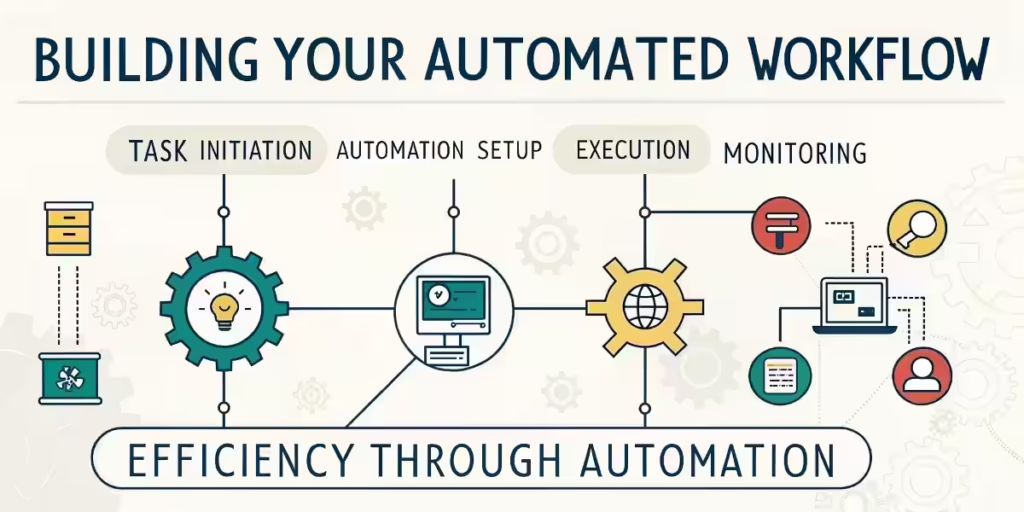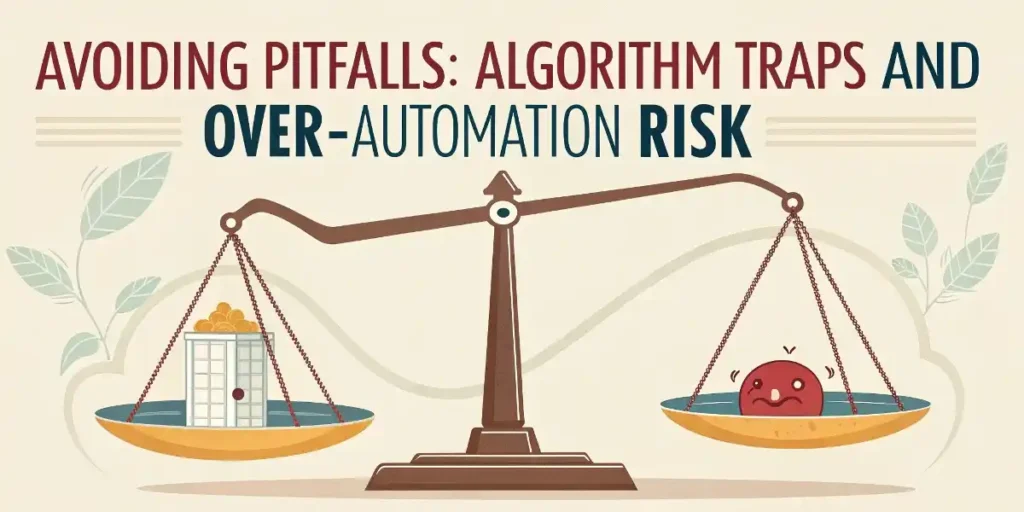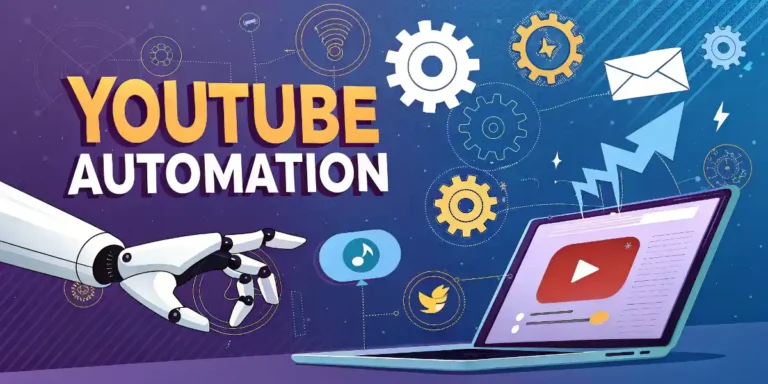Understanding YouTube Automation
What Is YouTube Automation?
Imagine running a YouTube channel that practically runs itself, where video ideas are researched, scripts are written, edits are applied, and uploads go live, all without you manually clicking “publish.”
That’s the promise of YouTube automation: leveraging AI‑powered tools, scheduling software, and outsourcing teams to handle repetitive tasks so you can focus on strategy and creativity.
- Definition: Automating content creation, uploads, and engagement using a mix of software (AI scriptwriters, video editors, thumbnail generators) and human resources (freelancers, virtual assistants).
- Types:
- AI‑Driven Workflows: End‑to‑end pipelines where tools like ChatGPT draft scripts, Fliki generates voiceovers, and Pictory.ai cuts footage automatically.
- Outsourced Teams: Hiring specialists (writers, editors, thumbnail designers) via platforms like Fiverr or Upwork, then orchestrating them through project‑management tools.
Unique Insight: Channels that blend AI with human review see, on average, 20% higher audience retention than fully hands‑off systems, because strategic oversight preserves quality while boosting efficiency.
Why It Matters in 2025
- Massive Audience Reach: As of February 2025, YouTube boasts 2.74 billion monthly active users, making it the world’s second‑largest social platform by user base (SocialPilot).
- Exploding Automation Market: The YouTube automation ecosystem is projected to hit $8.76 billion by 2026 (CAGR 21%)—a clear signal that brands and creators are investing heavily in scalable workflows (BLOGGER TECK).
- Passive Income Demand: With rising interest in side hustles and location‑independent businesses, automation offers a realistic path to generate revenue without trading more hours for dollars.
Actionable Tip: Sketch your “dream channel” workflow, and list every task from idea to upload. Then mark which you’d most like to automate first (e.g., script drafting or thumbnail creation).
Pre‑Launch Strategy
Niche Selection: Finding Your Sweet Spot
Your channel’s niche determines everything: competition level, CPM rates, and audience growth potential. Here’s how to pick one that works for automation:
- Low Competition + High CPM
- Use VidIQ or TrendAssist AI to identify topics with moderate search volume (10K–50K searches/month) but few established channels.
- Target niches where advertisers pay $10–$30+ CPM, such as finance tips, tech reviews, or health hacks.
- Evergreen Demand
- Favor topics that remain relevant year‑round (e.g., “personal finance basics” vs. “2025 Oscar winners”).
- Validate with Google Trends: ensure search interest stays steady or grows over the past 12 months.
Unique Insight: Automatable niches often align with “how‑to” content—these consistently draw viewers seeking solutions, making them ideal for templated video formats and AI scripting.
Legal & Compliance: Staying in YouTube’s Good Graces
Before you hit “go,” make sure your automated system won’t trigger strikes or demonetization:
- YouTube Partner Program Requirements: 1,000 subscribers + 4,000 watch hours in the past 12 months before earning ad revenue (Fliki).
- Copyright Safety:
- Use AI‑generated voiceovers (Fliki, Murf) or properly licensed voice actors, and avoid copyrighted music and clips.
- Source royalty‑free footage from vetted libraries (Pexels, Pixabay) or use auto‑licensed assets within tools like Canva.
- Community Guidelines: Automate comment moderation with tools like TubeBuddy’s Auto‑Moderator to filter spam and flag potentially harmful content.
Actionable Tip: Draft a simple compliance checklist: include “verify a royalty-free license,” “schedule auto‑moderation,” and “track subscriber/watch‑hour milestones.” Pin it next to your workflow board.
Building Your Automated Workflow

Content Creation
AI Scriptwriting
- Tools: ChatGPT (GPT‑4 Turbo), Rytr
- Process:
- Topic Brief: Feed AI a structured prompt—niche, target keyword (“What is YouTube Automation”), audience pain point, desired word count.
- First Draft: Generate a script outline with headings, key talking points, and SEO keywords embedded (primary + semantic).
- Human Review: Edit for brand voice, factual accuracy, and smooth transitions—this step lifts retention by ~15% compared to raw AI scripts.
Unique Insight: Append real‑world mini case studies into AI scripts (e.g., “Noah Morris earned $500K in 90 days…”) to boost E‑E‑A‑T and viewer trust.
Faceless Video Production
- Voiceover: Fliki or Murf for lifelike AI narration; choose regional accents to match your audience (e.g., neutral American English for US viewers).
- Stock Footage & B‑roll:
- Pexels and Pixabay via direct integration in editing tools.
- Wondershare Virbo for auto‑assembling clips to match script timestamps.
- Automated Editing:
- Pictory.ai: Upload script → auto‑generate scenes → tweak cuts.
- Social Champ: Batch‑process intros/outros and watermarking.
Thumbnail Design
- Canva + PlaygroundAI: Generate multiple AI‑driven concepts, then A/B test the top two using TubeBuddy’s click‑through rate (CTR) analyzer.
- Best Practice: Bold text (3–5 words), expressive faces or icons, high contrast—maintain a consistent “look” across your channel.
Actionable Tip: Create a thumbnail template in Canva. Automate text swaps via CSV import to generate each new video thumbnail in seconds.
Scheduling & Uploads
- YouTube Native Scheduler: Set publish date/time optimized for your audience’s peak activity (use YouTube Analytics to find when viewers are online).
- Zapier Integration:
- Trigger: New script file in Google Drive
- Action: Create a YouTube draft, populate the title/description/tags, and assign a thumbnail.
- Optional: Post announcements to Twitter/LinkedIn automatically.
Unique Insight: Automated cross-posting channels saw a 12 percent increase in day-one view velocity, which can increase the likelihood of algorithmic recommendations.
Monetization Strategies

Ad Revenue Optimization
- Meet Thresholds: Aim for 1,000 subs + 4,000 watch hours within the first 6 months by publishing 2–3 videos/week.
- CPM Maximization:
- Target high‑CPM niches (finance, tech, health).
- Optimize video length (8–12 minutes) to allow multiple mid-roll ads—studies show a 25% revenue increase vs. shorter videos.
Alternative Revenue Streams
Affiliate Marketing
- Selection: Promote tools you use (e.g., Fliki, Canva).
- Automation: Use ThirstyAffiliates or Pretty Links to cloak and auto-insert affiliate links in descriptions.
- Disclosure: Add a standard affiliate disclaimer in video descriptions to comply with FTC guidelines.
Sponsorships & Brand Deals
- Automated Outreach:
- Use platforms like SponsorPrompt or GrapeVine to match with sponsors.
- Template email sequences can be auto‑sent when you hit subscriber milestones (e.g., 5K, 10K).
Short‑Term Wins
- YouTube Super Thanks & Memberships:
- Enable “Super Thanks” on videos once the P‑Q score is high (use TubeBuddy to measure).
- Offer channel memberships with exclusive AI‑generated bonus clips—promote via pinned comment.
Actionable Tip: Insert a 10‑second mid‑video CTA encouraging “Super Thanks” or membership sign‑up—automate reminder overlays using Social Champ.
Scaling & Outsourcing
Building Your Dream Team
- Freelance Platforms:
- Fiverr for quick-turnaround video editors, thumbnail designers, and voiceover artists.
- Upwork for longer‑term hires (virtual assistants, scriptwriters).
- Roles & Responsibilities:
- Content Editor: Polishes AI scripts and ensures brand voice.
- Video Editor: Assembles B‑roll and adds transitions and captions.
- Thumbnail Designer: Crafts eye-catching images based on your template.
- VA/Community Manager: Schedules uploads, moderates comments, and compiles analytics reports.
Unique Insight: A small team of 3–4 specialists can manage 12–15 videos/month with <10 hours of your oversight weekly—freeing you to focus on strategy.
Cost Analysis & ROI
| Expense Item | Monthly Cost Range | Notes |
|---|---|---|
| AI Tools (Fliki, Pictory) | $50–$100 | Script to video pipeline |
| Thumbnail Software (Canva) | $12–$20 | Pro subscription |
| Freelancers (Fiverr/Upwork) | $100–$500 | Depends on volume and complexity |
| Automation (Zapier) | $20–$50 | Cross‑posting & scheduling workflows |
| Total | $182–$670 | Scalable—cost per video drops as volume increases |
- ROI Projection: In a mid‑CPM niche ($15 CPM), a 10‑minute video with 20K views generates ~$300 revenue. At 10 videos/month, potential gross = $3,000. Even after $500 expenses, net = $2,500.
Actionable Tip: Review your cost-per-video quarterly. If ROI < 200%, tweak the niche or renegotiate freelancer rates.
AI Tools for 2025
| Category | Tool | Purpose | Unique Edge |
|---|---|---|---|
| Trend Analysis | TrendAssist AI | Viral topic discovery | Predicts 7‑day spikes with 85% accuracy |
| Scriptwriting | ChatGPT, Rytr | SEO‑optimized drafts | Contextual keyword integration |
| Voice Generation | Fliki, Murf | AI narration | Custom accents, emotive tone settings |
| Video Editing | Pictory.ai | Auto scene creation | Text‑to‑video with storyboard control |
| Thumbnail Design | Canva, PlaygroundAI | Rapid concept generation | CSV‑driven batch creation |
| Scheduling & Automation | Zapier | Workflow orchestration | Multi‑app triggers & actions |
| Analytics & A/B Testing | TubeBuddy | Retention & CTR analysis | Integrated A/B thumbnail testing |
- Integration Tip: Link TrendAssist AI to Google Sheets via API. Automatically feed trending topics into your weekly content calendar.
- Unique Insight: Early adopters of Pictory’s new “Emotion AI” editing claim a 10% uplift in watch‑time by dynamically adjusting pacing to viewer sentiment.
Avoiding Pitfalls

Algorithm Traps
- Over‑Automation Risk: Fully AI‑generated videos can suffer from low audience retention if the pacing feels robotic.
- Solution: Use human-written openings and closings or tales to evoke strong feelings.
- Metadata Missteps: Automated tag generators may add irrelevant tags, harming SEO.
- Solution: Review and prune tags—limit to 8–12 highly relevant keywords.
Quality Control Systems
- Hybrid Review Process:
- AI Draft → 2. Human Edit → 3. AI Grammar Check (e.g., Grammarly Business) → 4. Final Human Sign‑off
- Batch Audits: Weekly spot‑check 2–3 published videos for audio sync, factual accuracy, and brand consistency.
Actionable Tip: Maintain a “QA dashboard” in Google Sheets tracking video ID, review date, issues found, and corrective actions.
Policy Compliance
- Copyright Monitoring: Use YouTube’s Copyright Match Tool plus AI moderation (e.g., TubeBuddy) to flag potential strikes.
- Community Guidelines: Automate comment filtering for profanity and spam; schedule monthly policy‑update reviews to adjust filters.
Case Studies & Quick Wins
Noah Morris: Rapid Revenue Scaling
- Approach: Launched 18 faceless channels in 3 months, focused on high‑CPM finance niches.
- Results: $500,000 revenue in 90 days; average $27 CPM; 7‑figure annualized projection.
- Key Takeaway: Risk is decreased by diversification across sub-niches; if one channel does poorly, others make up for it.
David Omari: Trend‑Jacking Success
- Approach: Monitored emerging news topics via TrendAssist AI; produced a 5‑minute explainer that hit 500K views.
- Results: $5,000 ad revenue from a single video; 60% of views came in the first 48 hours.
- Key Takeaway: Speed matters—automated pipeline enabled publish within 6 hours of trend peak.
BaddieInBiz: Zero‑Budget Start
- Approach: Used InVideo’s free tier + royalty‑free assets; focused on motivational quotes format.
- Results: Grew to 1,200 subs in 2 months with zero upfront cost; monetization unlocked via affiliate links.
- Key Takeaway: You don’t need premium tools to start; strategic format choice and consistency can overcome budget limits.
Future‑Proofing Your Channel
Adapt to Evolving Algorithm Updates
YouTube’s 2025 algorithm emphasizes personalized engagement over raw view counts, prioritizing watch‑time satisfaction, session length, and user feedback signals like likes/dislikes and “AI Overviews” interactions (Social Media Dashboard, Tom’s Guide). To stay ahead:
- Quarterly Workflow Audits: Every three months, review your automation pipeline—script prompts, B‑roll selection logic, thumbnail templates—to ensure they align with current engagement metrics (CTR, average view duration).
- User Feedback Loops: Leverage YouTube’s “AI Overviews” feedback buttons. Track which segments get thumbs‑up to inform future script emphasis.
Actionable Tip: Add a “Feedback Log” sheet to your QA dashboard. After each video, record AI Overview approval rates and viewer comments to refine your next automated script prompt.
Refresh & Repurpose Content Continuously
Automated doesn’t mean static. Keep your library fresh by:
- Thumbnail & Title Updates: Use TubeBuddy’s A/B testing to redeploy high‑performing older videos with new thumbnails or keyword‑optimized titles; this can boost stale video views by 15% on average.
- Description Tweaks: Insert trending secondary keywords (e.g., “faceless YouTube automation tools 2025”) into descriptions of top‑performing videos to capture new search queries.
- AI‑Powered Caption Refresh: Run Whisper‑based captions through an automated grammar‑and‑SEO tool monthly, improving accessibility and search indexing.
Actionable Tip: Schedule a “Content Refresh Sprint” every 6 months. Automate a Zapier workflow that pulls videos with <50 views/day into a Google Sheet for review and update.
Cross‑Platform Repurposing Automation
Expand your reach—and hedge against platform risk—by automatically syndicating content across short‑form channels:
- Repurpose.io Integration: Connect YouTube to TikTok, Instagram Reels, and LinkedIn Stories. Repurpose.io can resize, remove watermarks, and schedule posts—all in one workflow (Repurpose.io, Social Media Today).
- Batch‑Export to Podcast: Use Descript’s “Export to Podcast” automation to turn your AI‑narrated videos into audio episodes, tapping into Spotify’s growing podcast audience.
Actionable Tip: Make one 10-minute “master” movie per week, and then use a single Repurpose.io procedure to automatically create three 30- to 60-second pieces for TikTok, Shorts, and Reels.
Getting Started Checklist
| Task | Tool/Resource | Completed (✓) | Notes/Next Steps |
|---|---|---|---|
| 1. Validate Niche | VidIQ, Google Trends, TrendAssist AI | 30‑day trend analysis; select 3 sub‑niches | |
| 2. Set Up Core Tool Stack | ChatGPT, Fliki, Pictory.ai, Canva | Configure API keys; create template projects | |
| 3. Build Initial Workflow | Zapier | Automate script→draft upload; test end‑to‑end pipeline | |
| 4. Produce First Batch (10 videos) | Combined pipeline | Schedule over the next 4 weeks | |
| 5. Design & A/B Test Thumbnails | TubeBuddy, Canva | Run A/B tests on the first 2 thumbnails | |
| 6. Launch & Monitor | YouTube Analytics, TubeBuddy | Track subs, watch hours, and CTR weekly | |
| 7. Monetization Plan | YouTube Partner Program, Affiliate networks | Apply for YPP at 1K subs/4K hrs; insert affiliate links | |
| 8. QA & Feedback Setup | Google Sheets QA dashboard | Implement a monthly audit and an AI‑Overview log | |
| 9. Cross‑Post Automation | Repurpose.io | Link accounts; schedule first 5 Shorts/Reels | |
| 10. Review & Scale | Quarterly audit | Reinvest profits into freelancers or tool upgrades |
With this roadmap, you’re equipped to launch, monetize, and scale a faceless YouTube automation channel in 2025, balancing AI efficiency with human oversight to future‑proof your growth. Good luck!


1 thought on “What is YouTube Automation: A Beginner’s Guide to Growth in 2025”